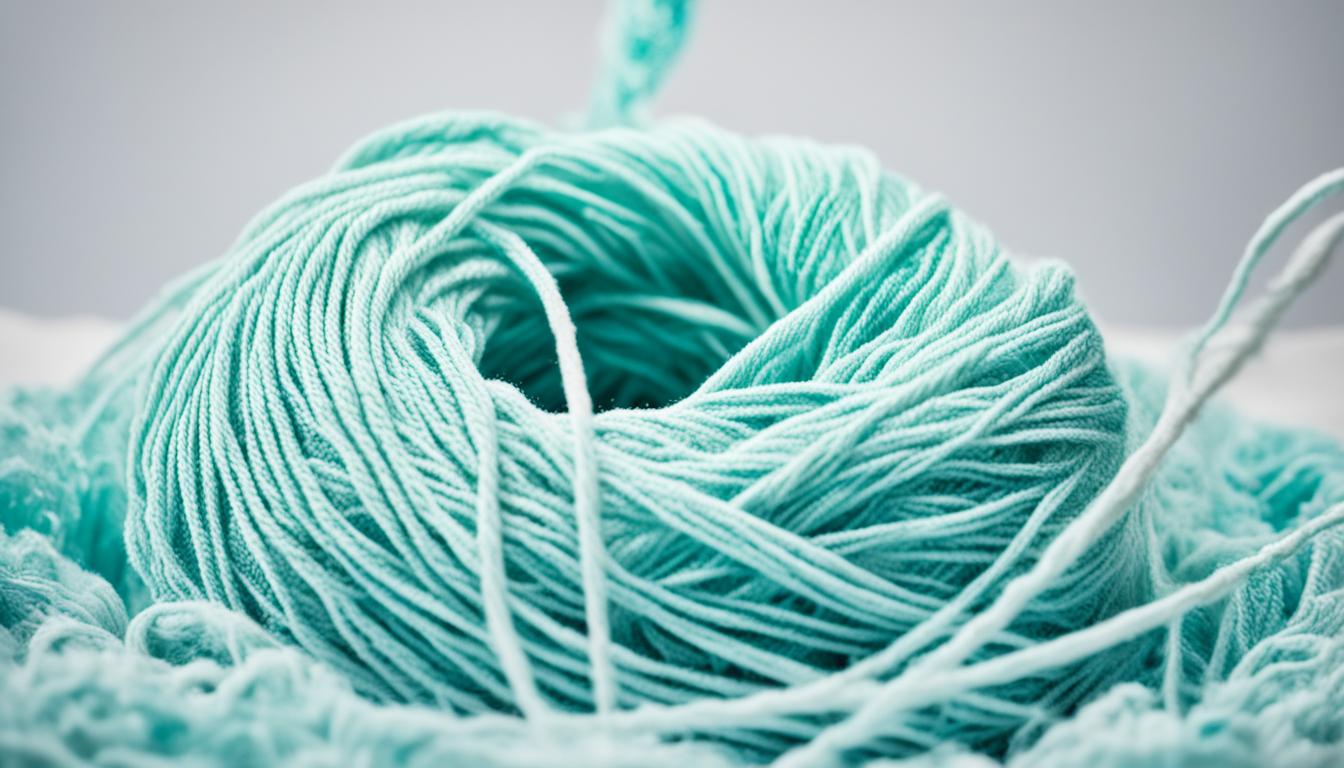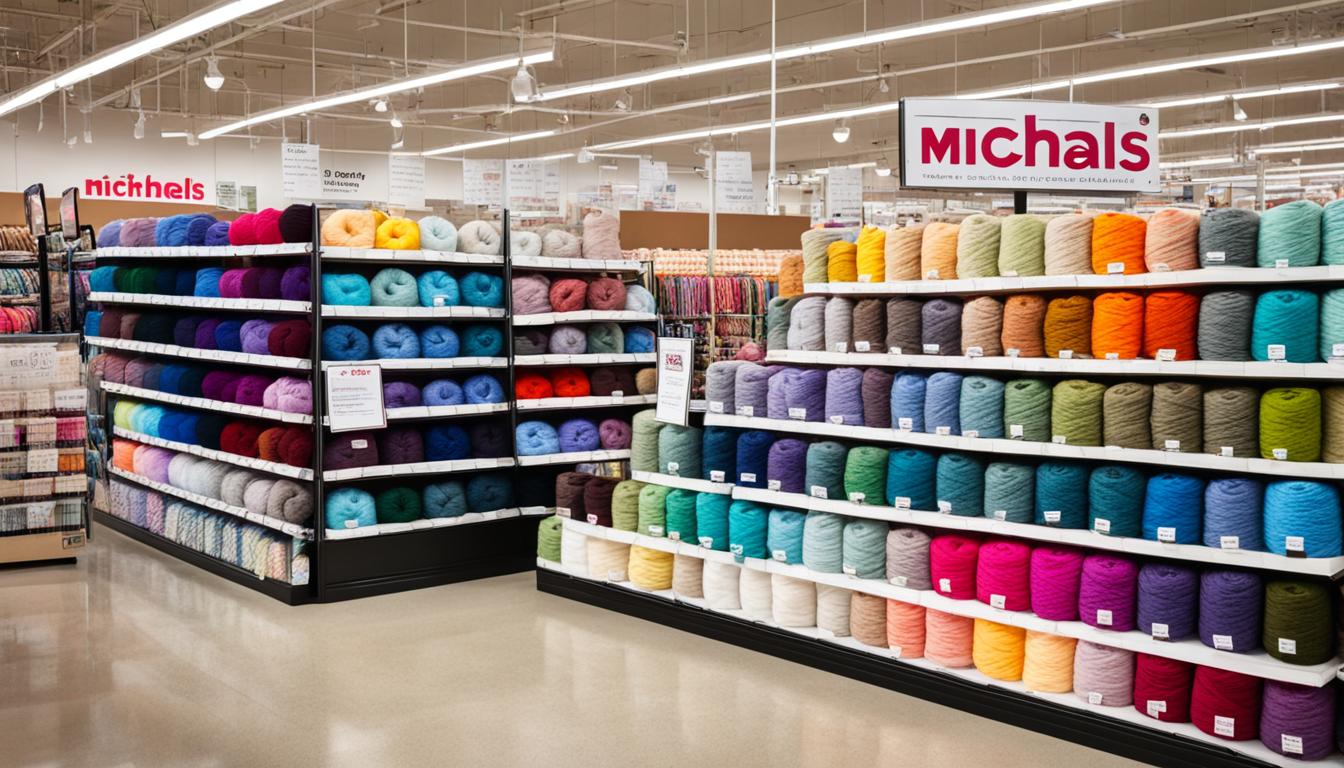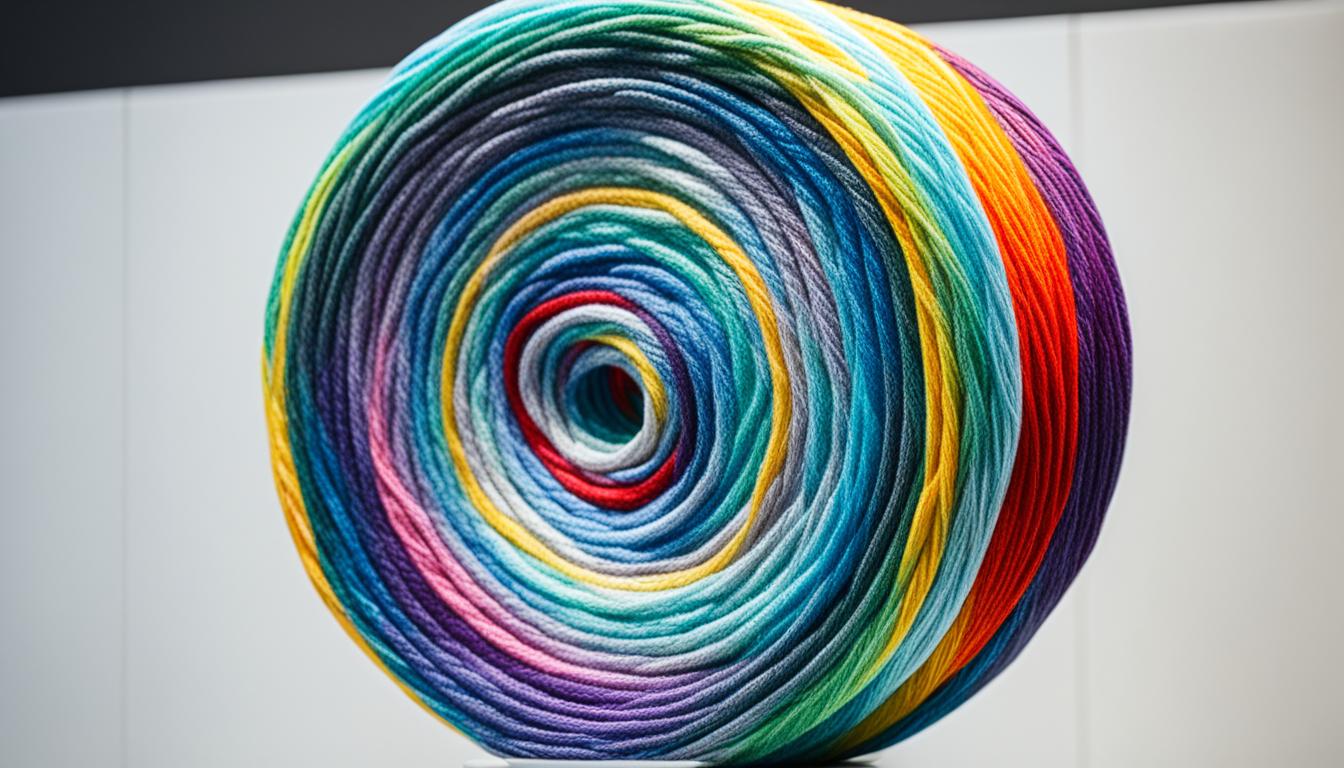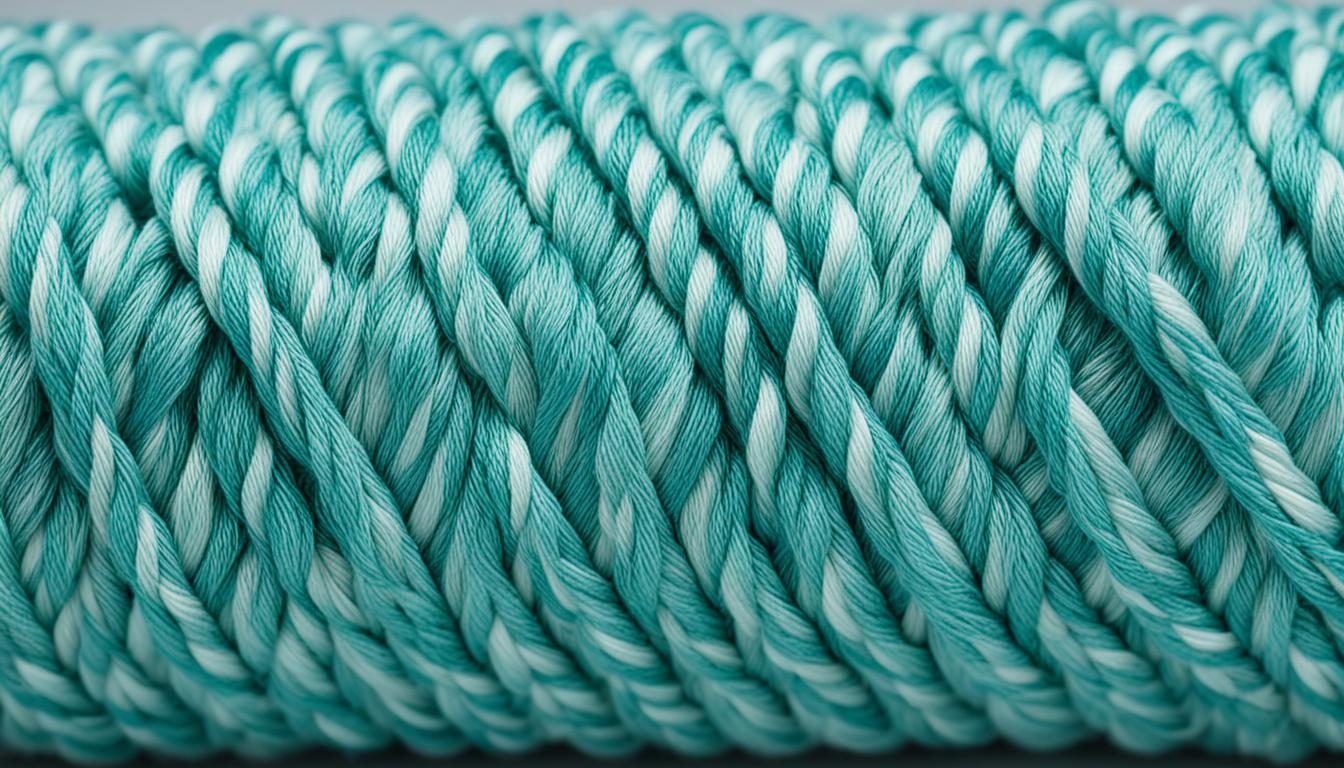Have you ever asked yourself if acrylic yarn stretches when washed? Does it lose its shape or become distorted? These inquiries are frequently raised by knitters and crafters who use acrylic yarn. Knowing how to properly care for acrylic yarn is crucial to guarantee that your projects come out just the way you envision.
Acrylic yarn is a popular choice due to its affordability and durability. However, misconceptions about its properties can lead to confusion and potential mishaps during the washing process. So, let’s dive deeper and uncover the truth about how acrylic yarn behaves when washed.
Key Takeaways:
- Acrylic yarn does not stretch when washed, but it can be temporarily stretched when wet.
- Gently steaming and stretching acrylic yarn can create a permanent increase in size.
- Following proper care instructions, such as washing in warm or cold water and drying on low temperatures, helps maintain the shape and elasticity of acrylic yarn.
- Acrylic yarn offers affordability, durability, and a wide range of color options, making it a practical choice for many knitting projects.
- Consider personal preferences, texture, care instructions, and environmental impact when choosing yarn for your projects.
The Benefits of Acrylic Yarn
Acrylic yarn has numerous properties that make it a sought-after choice for knitters. Not only is it cost-effective, but it also boasts excellent durability and ease of care. When compared to natural fibers, acrylic yarn is more budget-friendly, making it suitable for a wide range of projects. Its remarkable resistance to stretching and damage makes it ideal for items that require long-lasting quality. Another advantage of acrylic yarn is its machine-washable nature, ensuring convenience for everyday use.
By following proper care instructions, you can maintain the elasticity of acrylic yarn while enjoying its benefits. Whether you’re working on a cozy sweater or a stylish accessory, acrylic yarn provides the versatility and reliability you need for a successful knitting project.
“Acrylic yarn is cost-effective, durable, and easy to care for.”
Resistant to Stretching and Damage
One of the outstanding properties of acrylic yarn is its resistance to stretching and damage. This quality ensures that your finished projects retain their shape and integrity over time. Acrylic yarn holds up well to regular use and maintains its structure, making it perfect for items like blankets, scarves, and hats that are frequently worn or handled. Whether it’s a playful game of tug-of-war with your dog or multiple wash cycles, acrylic yarn stands up to the test.
Machine-Washable Convenience
Acrylic yarn’s machine-washable nature adds to its appeal. You can toss your finished creations into the washing machine without worrying about intricate hand-washing or delicate care instructions. This convenience is particularly valuable for projects that are expected to endure frequent washing, such as baby blankets or everyday wearables. By following the recommended care instructions, you can ensure that your acrylic yarn projects maintain their elasticity and stay in great condition for years to come.
Affordability and Color Options
Another advantage of acrylic yarn is its affordability. Compared to natural fibers like wool or cashmere, acrylic yarn is much more budget-friendly. This accessibility allows knitters to pursue their passion without breaking the bank. Furthermore, acrylic yarn offers an extensive range of color options, enabling you to unleash your creativity and find the perfect shade for any project. Whether you’re seeking bold and vibrant hues or subtle and neutral tones, acrylic yarn provides a kaleidoscope of color possibilities.
Next, we’ll share some valuable tips for working with acrylic yarn to ensure the best results for your knitting projects.
Tips for Working with Acrylic Yarn
When working with acrylic yarn, there are a few tips and tricks that can help you achieve the best results and prevent stretching. Here are our top recommendations:
1. Gauge Swatch for Sizing
Before starting your project, it’s essential to create a gauge swatch to ensure the correct sizing. Acrylic yarns can vary in texture and stretch, so it’s important to check your tension before diving into your main project. By following the recommended gauge, you’ll have better control over the final size and shape of your creation.
2. Explore Different Brands
There are numerous brands of acrylic yarn available, each with its unique properties and textures. To find the best acrylic yarn for your project, we recommend trying out different brands and reading reviews from other crafters. This way, you can discover the brand that suits your preferences and work with yarn that aligns with your desired outcome.
3. Mix with Other Fibers
If you want to enhance the texture and breathability of your project, consider mixing acrylic yarn with other fibers like wool or cotton. By blending fibers, you can create a combination that retains the benefits of acrylic yarn while incorporating the desired qualities of other materials. This can result in a more comfortable and versatile finished product.
4. Block Your Finished Project
After completing your project, blocking can work wonders in terms of improving the drape and removing any stiffness or unevenness. Blocking involves wetting or steaming your project and then gently reshaping it to the desired dimensions. This process helps set the stitches in place and provides a professional finish. Be sure to follow the care instructions specific to your acrylic yarn when blocking.
By following these tips, you can maximize your experience when working with acrylic yarn and prevent stretching. Remember to enjoy the creative process, experiment with different techniques, and let your imagination run wild!
Pros and Cons of Acrylic Yarn
When considering acrylic yarn for your knitting projects, it’s important to weigh the pros and cons. Acrylic yarn offers several advantages that make it a popular choice, but it also comes with a few drawbacks to keep in mind.
Pros of Acrylic Yarn
- Affordability: Acrylic yarn is much more budget-friendly compared to natural fibers, making it a cost-effective option for projects.
- Durability: One of the biggest strengths of acrylic yarn is its durability. It is highly resistant to stretching and damage, making it perfect for projects that require longevity.
- Ease of Care: Acrylic yarn is machine-washable, which makes it incredibly convenient for everyday use. You can easily toss your finished projects in the washing machine without worrying about delicate care instructions.
- Color Options: Acrylic yarn comes in a wide range of colors, offering you endless possibilities for your knitting projects. Whether you prefer vibrant hues or soft pastels, you’re sure to find the perfect shade.
Cons of Acrylic Yarn
- Less Breathable: Acrylic yarn may be less breathable compared to natural fibers, which can affect comfort, especially in warm climates or during physical activity.
- Plastic-Like Feel: Some knitters and wearers of acrylic yarn items may find that it has a slightly plastic-like feel compared to the softness of natural fibers like cashmere or silk.
Despite these drawbacks, acrylic yarn remains a popular choice for many knitters due to its affordability, durability, and ease of care. However, individuals with specific concerns about breathability and texture may prefer to explore natural fiber options for their projects.
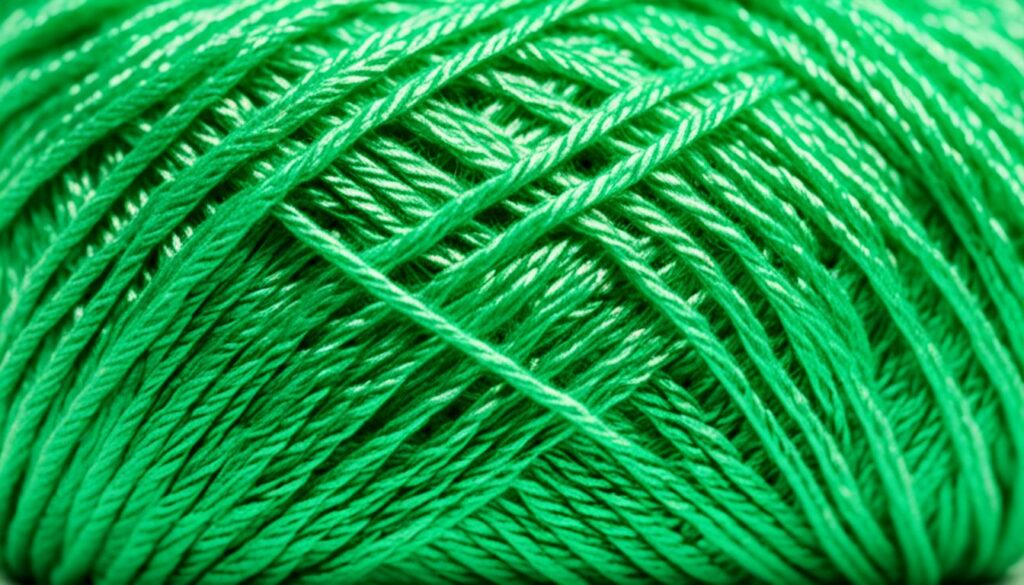
Washing and Caring for Acrylic Yarn
Proper care is essential to maintain the quality and longevity of your acrylic yarn projects. By following these care instructions, you can keep your acrylic yarn items looking vibrant and in good condition for years to come.
Pre-Treat Stains: Before washing your acrylic yarn items, it is recommended to pre-treat any stains. Gently dab the stained area with a stain remover or a mild detergent to help remove the stain more effectively.
Choose the Right Detergent: When washing acrylic yarn, opt for a gentle detergent that is suitable for delicate fabrics. This will help preserve the softness and integrity of the yarn fibers.
Machine-Washing: Acrylic yarn can be safely washed in a standard laundry cycle using warm or cold water. To prevent wrinkles, select the permanent press cycle on your washing machine. This setting facilitates a gentle agitation that protects the yarn from excessive stretching or damage.
Hand-Washing: For delicate acrylic yarn items, such as intricate knitted or crocheted pieces, it is best to hand-wash them. Fill a basin or sink with lukewarm water and add a small amount of gentle detergent. Gently swish the item in the soapy water, then rinse it thoroughly with clean water. Avoid wringing out the item to prevent stretching and instead gently squeeze out excess water.
Drying: To dry acrylic yarn items, it is important to avoid hanging them as this can cause stretching and create unwanted shape distortions. Instead, lay the items flat on a clean, dry towel or a drying rack. Allow them to air dry naturally. For optimal results, reshape the item as it dries to preserve its intended shape.
Tumble Drying on Low: If you choose to tumble dry your acrylic yarn items, it is crucial to select the low-temperature setting. High heat can cause the yarn to become brittle or melt. Remove the items from the dryer while they are still slightly damp to reduce the risk of over-drying and potential shrinkage.
Avoid Placing Stained Acrylic Items in Hot Dryers: If your acrylic yarn item has a stain, it is essential to avoid placing it in a hot dryer. The heat can set the stain, making it more difficult to remove. Instead, treat the stain and air dry the item to ensure the best possible outcome.
Handling Wrinkles: If your acrylic yarn item becomes wrinkled during washing or drying, you can gently steam it using a garment steamer or a steam iron on a low setting. Always use a pressing cloth to avoid direct contact between the iron and the item to prevent melting or damaging the fibers.
Proper Storage: When storing acrylic yarn, ensure that the items are clean and completely dry to prevent moisture-related issues such as mold or mildew. Fold the items neatly and store them flat in a cool, dry place. Knitted garments should never be hung up, while shirts and blouses made with woven acrylic can be stored on hangers with ample space between garments to prevent wrinkling.
Quick Tips:
- Pre-treat stains before washing acrylic yarn items
- Choose a gentle detergent suitable for delicate fabrics
- Machine-wash using warm or cold water on the permanent press cycle
- Hand-wash delicate acrylic yarn items, then squeeze out excess water gently
- Lay items flat to dry, reshaping them as needed
- Tumble dry on low temperatures and remove while slightly damp
- Avoid placing stained acrylic items in hot dryers
- Gently steam or use a low-heat iron to remove wrinkles
- Store clean, dry acrylic yarn items flat in a cool, dry place
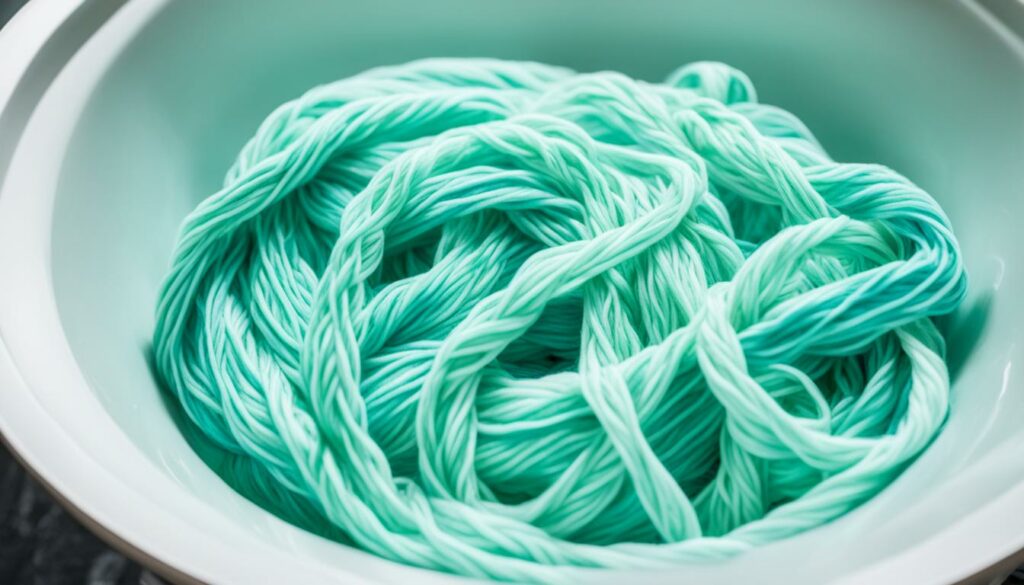
Follow these care instructions to keep your acrylic yarn projects looking their best. With proper care, your acrylic yarn items will maintain their vibrant colors, softness, and shape, delighting you and adding charm to your everyday life.
Ironing and Storing Acrylic Yarn
Ironing acrylic yarn requires a delicate touch to avoid damaging the fibers. To prevent melting, it’s crucial to use a very low iron temperature and a pressing cloth over the yarn. Ironing should be done with a gentle pressing motion, rather than sliding the iron back and forth. This helps to maintain the integrity of the acrylic yarn while removing any wrinkles or creases. Always start with a small inconspicuous area to test the heat tolerance of the yarn before proceeding.
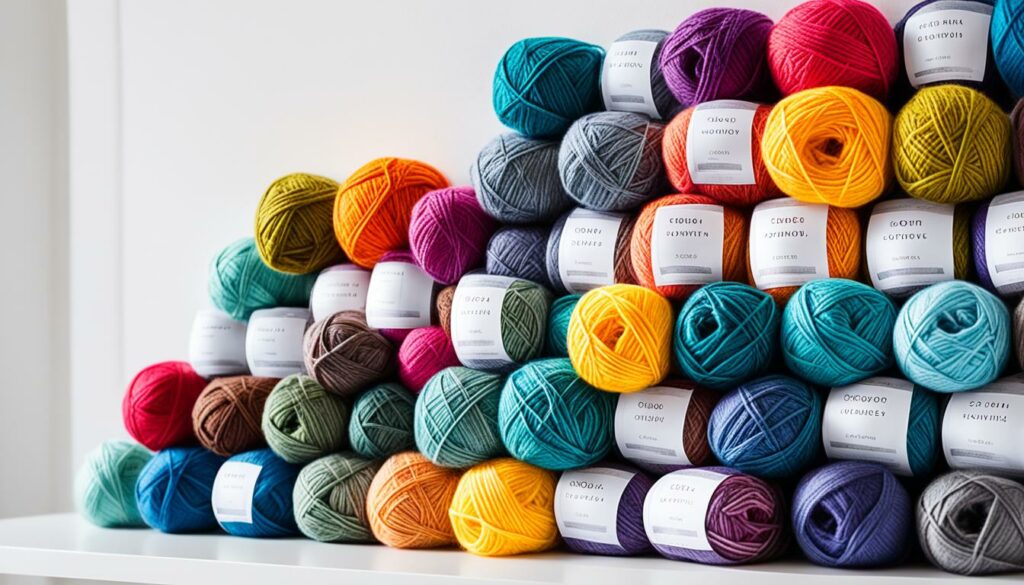
When it comes to storing acrylic yarn, the key is to keep it protected and prevent unnecessary stretching. Before storing, it’s important to wash and dry the yarn thoroughly to remove any dirt or oils that may attract pests. Once clean and dry, fold the yarn neatly and store it flat in a drawer or a plastic storage container. This helps to maintain the shape and structure of the yarn, preventing it from stretching over time.
Tip: Avoid storing sweaters and other knitted garments made with acrylic yarn on hangers, as this can lead to stretching and misshaping. Instead, fold these items and store them flat. If you have shirts or blouses made with woven acrylic fabric, they can be stored on hangers with ample space between garments to prevent wrinkling.
Acrylic Yarn and Environmental Impact
When it comes to considering the environmental impact of our crafting choices, it’s important to take a closer look at acrylic yarn. Made from synthetic materials derived from petroleum, acrylic yarn has been associated with detrimental effects on the environment. Although some companies are making efforts to reduce their environmental footprint by using recycled materials or adopting sustainable practices, acrylic yarn is generally not considered an eco-friendly option.
However, there are alternatives for knitters who prioritize environmental sustainability. Natural fiber options, such as cotton, linen, wool, or bamboo, offer a more eco-friendly choice. These fibers are biodegradable, renewable, and typically have a lower environmental impact compared to acrylic yarn.
By choosing sustainable yarn options, we can contribute to minimizing the use of non-renewable resources and reducing the carbon footprint associated with our crafting projects. Additionally, using natural fibers can be a way to support fair trade practices and promote ethical sourcing.
Eco-friendly Yarn Options
“When it comes to sustainable yarn options, there are a wide variety of choices available for environmentally conscious knitters. Here are a few examples:”
| Yarn Type | Material | Environmental Benefits |
|---|---|---|
| Organic Cotton Yarn | Organic cotton | Grown without harmful chemicals or pesticides |
| Linen Yarn | Flax plant fibers | Renewable and biodegradable |
| Wool Yarn | Natural sheep wool | Renewable and biodegradable, provides insulation and breathability |
| Bamboo Yarn | Bamboo fibers | Fast-growing and renewable, requires less water and pesticides compared to cotton |
These sustainable yarn options not only minimize the environmental impact but also offer unique qualities and textures that can enhance your knitting projects. When considering eco-friendly yarn, do some research and look for certifications like GOTS (Global Organic Textile Standard) or Fair Trade to ensure that you are making a conscious choice.
By incorporating sustainable yarn choices into our knitting projects, we can reduce our ecological footprint and contribute to a more sustainable future.
Acrylic Yarn and Texture
When it comes to the texture of acrylic yarn, it’s important to note that it can have a slightly different feel compared to natural fibers. While some high-quality acrylic yarns are softer and more pliable, they may still not have the same luxurious feel as fibers like cashmere or silk. Acrylic yarn can sometimes have a slight plastic-like texture, which is inherent to its synthetic nature.
However, advances in yarn manufacturing have led to the development of softer and more comfortable acrylic yarn options. Some brands offer acrylic yarn that is specifically designed to mimic the softness of natural fibers. These yarns have a finer texture and a smoother finish, making them more enjoyable to work with.
When choosing acrylic yarn for your project, consider your texture preferences. If you prioritize softness and want a yarn that feels more like natural fibers, look for high-quality acrylic yarns that are known for their exceptional softness and pliability. Reading reviews and feeling the yarn in person can also help you gauge its texture and determine if it meets your expectations.
An important consideration when it comes to texture is also the type of project you’re working on. Acrylic yarn’s slightly firmer texture may be better suited for projects that require structure and durability, such as blankets, bags, or amigurumi toys. On the other hand, if you’re making clothing items that are meant to drape and flow, natural fibers might offer a softer and more luxurious texture.
Why Choose Acrylic Yarn
Despite the drawbacks, there are several advantages and reasons to choose acrylic yarn for your knitting projects.
Affordability
One of the main advantages of acrylic yarn is its affordability. Compared to natural fibers, acrylic yarn is significantly more budget-friendly. This makes it the ideal choice for knitters who want to create beautiful and high-quality items without breaking the bank.
Durability
Acrylic yarn is known for its durability, making it perfect for projects that will see heavy use or frequent washing. Unlike some natural fibers, acrylic yarn is highly resistant to stretching and damage, ensuring that your creations will stand the test of time.
Easy Care
Another reason to choose acrylic yarn is its ease of care. Acrylic yarn is machine-washable, which means you can simply toss your finished projects into the washing machine for a quick and convenient clean. This makes it ideal for everyday items like blankets, scarves, and hats that need regular washing.
Wide Range of Color Options
Acrylic yarn offers a vast array of color options, allowing you to find the perfect shade for any project. Whether you prefer vibrant and bold hues or soft and subtle tones, acrylic yarn has something to suit every aesthetic and style.
“Acrylic yarn provides a cost-effective and durable solution for knitters, with easy care and a wide range of color options.”
So, if you’re looking for an affordable, durable, and easy-to-care-for yarn that offers a plethora of color choices, acrylic yarn is the perfect choice for your knitting projects.
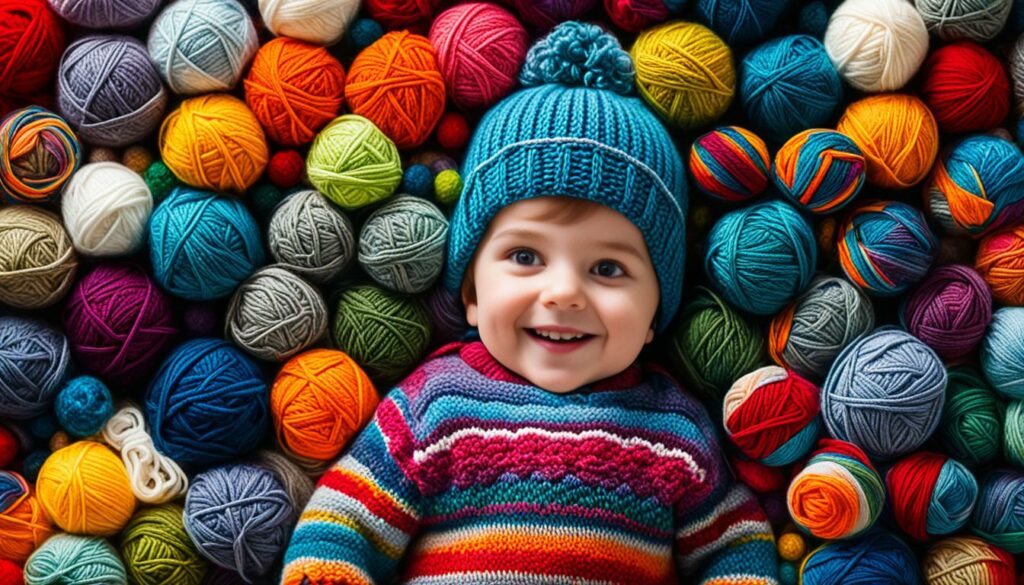
| Advantages of Acrylic Yarn |
|---|
| Affordable |
| Durable |
| Easy to care for |
| Wide range of color options |
Proper Care for Acrylic Fabric
When it comes to caring for acrylic fabric, a few simple steps can help you maintain its quality and longevity. Acrylic fabric is known for its quick-drying properties and resistance to mildew, odor absorption, insect infestation, and deterioration. Follow these care instructions to keep your acrylic fabric looking its best.
Washing Acrylic Fabric
Washing acrylic fabric is a breeze with a regular laundry detergent and warm or cold water. Start by pre-treating any stains before washing. Gently rub a small amount of detergent directly onto the stained area, then let it sit for a few minutes. This will help lift the stain and ensure a thorough cleaning.
Next, place the acrylic fabric in the washing machine. Choose a gentle cycle and use warm or cold water to avoid excessive heat that could damage the fabric. Avoid using bleach or harsh chemicals, as they can weaken the fibers over time.
After the washing cycle is complete, remove the acrylic fabric from the machine promptly. Avoid over-drying or leaving it in the dryer for extended periods, as excessive heat can cause shrinking or stretching. Instead, remove the fabric while it is still slightly damp to finish drying.
Stain Removal Tips
For tougher stains, such as grease or oil, it’s best to pre-treat them before washing. Here are some tips to help you remove common stains from acrylic fabric:
- Grease or oil: Blot the stain with a clean cloth to remove any excess grease or oil. Apply a small amount of dish soap directly to the stain and gently rub it in. Let it sit for a few minutes before rinsing with warm water.
- Ink: Dab the stain with a cotton ball soaked in rubbing alcohol. Be sure to test the alcohol on an inconspicuous area of the fabric first to ensure it doesn’t cause any damage.
- Red wine: Blot the stain with a clean cloth to remove as much wine as possible. Mix equal parts dish soap and hydrogen peroxide, then apply it to the stain. Let it sit for a few minutes before rinsing with warm water.
Proper Storage
To keep your acrylic fabric in top condition, it’s important to store it correctly. Before storing, ensure that the fabric is clean and completely dry. Folding the fabric and storing it flat is the best way to prevent stretching or deforming.
For sweaters and knitted garments, it’s recommended to avoid hanging them up for storage, as this can cause stretching. Instead, fold them carefully and place them in a drawer or on a shelf. Shirts and blouses made with woven acrylic fabric can be stored on hangers, but make sure there is ample space between garments to prevent wrinkling.
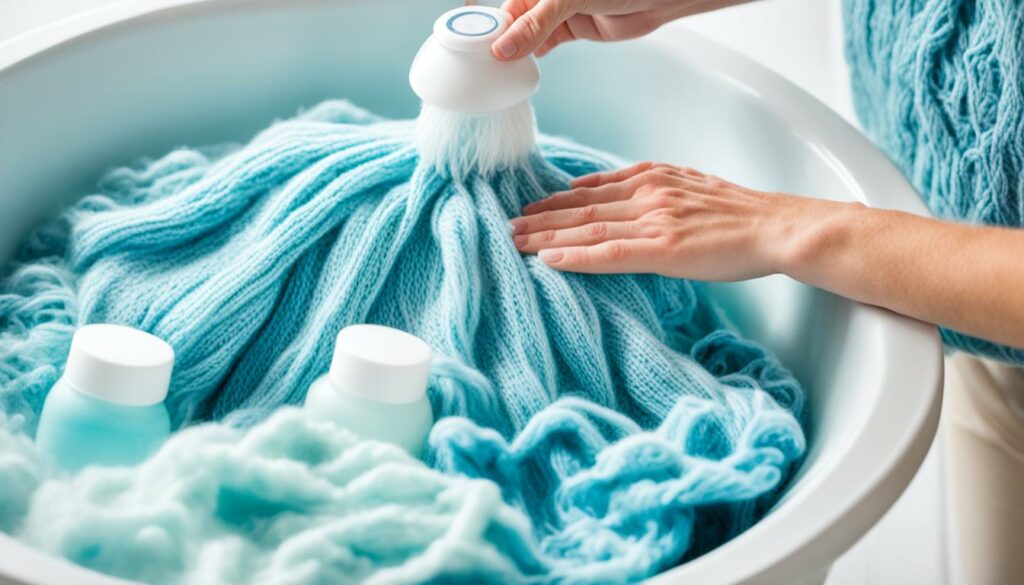
| Care Instructions | Do’s | Don’ts |
|---|---|---|
| Washing | Use a regular laundry detergent Wash in warm or cold water |
Use bleach or harsh chemicals Over-dry or leave in the dryer for too long |
| Stain Removal | Pre-treat stains before washing Blot or dab stains gently |
Rub or scrub vigorously Use heat or hot water on stains |
| Storage | Ensure fabric is clean and dry Fold and store flat |
Hang knitted garments for storage Cram garments together on a hanger |
Acrylic Fabric and Environmental Concerns
Acrylic fabric is a synthetic material derived from petroleum, which raises concerns about its environmental impact. We share the concerns of activists who worry about the effects of acrylic fabric on our planet. One of the primary concerns is the potential shedding of microplastics during washing. Unlike natural fibers, acrylic fabric doesn’t biodegrade and can contribute to the growing problem of microplastic pollution in our waterways.
Another concern is the use of toxic materials in the manufacturing process of acrylic fabric. The production of acrylic fabric involves the use of chemicals that may have adverse effects on human health and the environment. These chemicals can find their way into water sources, soil, and the air, impacting ecosystems and potentially posing risks to living organisms.
For those who prioritize environmental sustainability, exploring eco-friendly fabric options is a more suitable choice. By opting for materials with a lower environmental impact, we can contribute to a healthier planet.
The Environmental Impact of Acrylic Fabric
The production of acrylic fabric entails the consumption of non-renewable resources, as it is derived from petroleum. This extraction process has implications for climate change and the depletion of fossil fuel reserves. Additionally, the manufacturing process of acrylic fabric consumes significant amounts of water and energy, contributing to greenhouse gas emissions. These factors cumulatively contribute to the overall environmental impact of acrylic fabric.
Furthermore, as acrylic fabric does not biodegrade, items made from this material can persist in landfills for an extended period. This further exacerbates the waste management challenges posed by synthetic textiles.
Eco-Friendly Fabric Options
To address the environmental concerns associated with acrylic fabric, there are several eco-friendly fabric alternatives that can be considered:
- Organic Cotton: Produced without the use of harmful chemicals, organic cotton is a sustainable choice. It is biodegradable and requires less water compared to conventional cotton.
- Linen: Made from flax fibers, linen is a natural and durable fabric. It requires fewer resources and has a low environmental impact.
- Tencel (Lyocell): Derived from sustainably sourced wood pulp, Tencel is a type of rayon that is known for its eco-friendly manufacturing process. It is biodegradable and has a lower impact on water usage.
- Hemp: Hemp fabric is made from the fiber of the cannabis plant and is known for its durability and breathability. It requires fewer pesticides and water compared to other crops.
By choosing these eco-friendly fabric options, we can reduce our environmental footprint and contribute to a more sustainable fashion industry. It’s important to consider the environmental impact of the materials we use in our everyday lives, including the fabrics we choose for our clothing and textiles.
A Comparison of Fabric Options
| Fabric Option | Environmental Impact | Biodegradability | Resource Usage |
|---|---|---|---|
| Acrylic | High | No | Non-renewable resources, water, energy |
| Organic Cotton | Moderate | Yes | Less water, no harmful chemicals |
| Linen | Low | Yes | Less water, fewer resources |
| Tencel (Lyocell) | Low | Yes | Sustainably sourced wood pulp |
| Hemp | Low | Yes | Less water, fewer pesticides |
As we make conscious choices about the fabrics we use, we can contribute to a more sustainable and environmentally friendly textile industry. By opting for eco-friendly fabric options, we can reduce our impact on the environment and support a healthier planet for future generations.

Conclusion
In conclusion, acrylic yarn is a versatile option for knitting projects. It does not stretch when washed, but it may temporarily stretch when wet. To maintain the shape and elasticity of acrylic yarn, it is important to follow proper care instructions. Washing it in warm or cold water and drying it on low temperatures will help preserve its quality. Additionally, acrylic yarn offers affordability, durability, and a wide range of color options, making it a practical choice for many knitters.
However, it’s important to note that acrylic yarn may not be suitable for individuals with specific concerns about breathability and environmental impact. In those cases, exploring natural fiber options may be a better choice. Ultimately, the decision to use acrylic yarn depends on careful consideration of texture, care instructions, and personal preferences.
We hope this article has helped you understand the characteristics and care instructions for acrylic yarn. Whether you choose acrylic or natural fibers, happy knitting!
